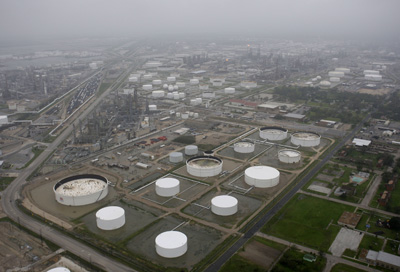
The price of gasoline jumped by 40 cents a gallon over the weekend because of a hurricane that didn’t even make the leaves rustle in these parts. Why? Because 30 percent of the U.S. oil refining capability is offline.
Hurricane Ike forced the refineries along the Gulf Coast to shut down. The lack of refinining capability coupled with an already short supply of fuel has caused the price run-up according to the Web site, The Oil Drum, which sees the 10-day shutdown causing price hikes and shortages at least into October.
I have said that it is likely to take a week or two to get refinery production up to pre-Ike levels. Suppose it takes 10 days. Adding 10 days to the date of the hurricane (September 12) brings us to September 22. If it takes an average of 18.5 days to get product from Texas to New Jersey by pipeline, it will take until approximately October 10 before supplies are back to normal. It could be a little shorter than this, or quite a bit longer.
Of the 15 top-producing oil refineries in the United States, only four are located in hurricane-safe areas. One of them is the Flint Hills refinery along the Mississippi River in Minnesota. That refinery is ranked #12 in the country.
Some politicians have argued for an easing of regulations to allow more refineries to be built. But Ralph Nader’s Public Citizen says it’s not environmental regulations preventing new refineries.
From 1975 to 2000, the U.S. Environmental Protection Agency (EPA) received only one permit request for a new refinery. And in March, EPA approved Arizona Clean Fuels’ application for an air permit for a proposed refinery in Arizona. In addition, oil companies are regularly applying for – and receiving – permits to modify and expand their existing refineries.[1]
And even the oil industry admits that just because a new refinery hasn’t been built in over 30 years, doesn’t mean refining capacity hasn’t increased. Says a Political Fact Check on the St. Petersburg Times Web site…
The industry has found it costs less money and takes less time to expand existing facilities, he said. Over the past 15 years, the U.S. refining industry has added the equivalent of one new, state-of-the-art refinery a year, each with a capacity to refine 150,000 to 300,000 barrels per day.
A new significant oil refinery hasn’t been built in the U.S. since 1976, but smaller ones have been. And South Dakota may be the next lab rat to see how easily a major refinery can be constructed. In June, voters — thanks mostly to the votes of those in populated areas — approved rezoning some rural county land for a new refinery.
Last week, a South Dakota agency approved a draft air quality permit for the project.
According to Hyperion’s application, the center each year would emit nearly 2,000 tons of carbon monoxide, 773 tons of nitrogen oxides, more than 1,000 tons of particulate matter, 863 tons of sulfur dioxide and 473 tons of volatile organic compounds.
But that’s not what has many opponents working — against long political odds — to prevent the refinery. They say the oil to be refined is what will cause the most environmental damage.
Largely overlooked in the discussion has been the source and type of crude oil — Canadian tar sands — to be refined at the Hyperion facility. Canadian tar sands are probably the dirtiest source of oil on earth, and mining tar sands has created what might be the most polluted area in North America. Tar sands development in northeast Alberta has devastated 180 square miles of boreal forest. The process uses prodigious amounts of fresh water, and much of the water ends up so toxic it kills any wildlife that touches it. Millions of gallons of this poisoned water are now impounded in hundreds of toxic lakes and ponds.
But at least there’s no hurricanes in South Dakota.
